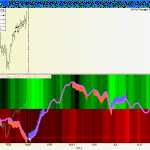Stock Market Spring Fever | Uncommon Wisdom Daily

Last week we discussed the upcoming seasonal bias to the S&P 500. How do we know this? Thanks to our trusty seasonality chart on the S&P 500.
Phil Erlanger years ago created a great tool for seasonal tendencies for stocks, indexes and ETFs. The current reading on the S&P 500 or even the Russell 2000 is key for all investors.
The months of January and February for the S&P 500 have been a struggle. That is the bad news.
The good news is, this might be about to change.
Phil Erlanger, with whom I have worked for eons, has a great data series that tracks seasonality.
The chart below shows the seasonal trend for the S&P 500 (magenta line). Then we shade in blue the best periods to be long and in orange the best periods to be short.
A heat map exists behind these lines, which is bright green for strong days and bright red for weak days.
The potential for some nice upside is a clear-and-present possibility and guess what — it starts today and runs to May 6.
Remember, seasonality is only a setup indicator. But if you see the S&P 500 begin to rise, like it has the past week, then you will know it is alive and well just like the long-awaited spring weather.
If the seasonal strength does not appear, then that will be very telling because the market will have squandered a key opportunity for an advance. Instead of nice spring weather, we could end up with a series of trading tornados.
How do we avoid them? By facing …
Buffett: Time to Bet on America
In a recent MarketWatch article, Warren Buffett claimed:
“Though we invest abroad as well, the mother lode of opportunity resides in America. [The] dynamism embedded in our market economy will continue to work its magic.”
James DiGeorgia agrees wholeheartedly with Mr. Buffett. In fact, his research says we’re about to see the greatest explosion of wealth in American history …
One that sends the Dow to 30K+ … and gives a select group of investors the opportunity to earn even bigger returns than Berkshire Hathaway!
It’s all thanks to what James calls the coming “T.E.M.” Boom. Get all the details in this urgent new video.
Internal Sponsorship
Investors’ Least-Favorite 4-Letter Word
This week are moving on to begin a discussion of a four-letter word that many do not like to talk about: risk.
Merriam-Webster defines it as “the possibility of loss or injury.”
As it relates to investing, risk is the chance an investment will lose value.
Investments that have a higher risk will have a higher “beta,” which is a measure of volatility. Here’s how it works:
A stock with a beta of 1 will move the exact same amount as the market.
A stock with a beta of 1.20 will be 20% more volatile than the market.
A stock with a beta of 0.75 will be 25% less volatile than the market.
When the overall stock market or the S&P 500 is moving higher, then you want to own higher-beta names.
When stock market or S&P 500 is moving lower, then you want to lower the beta of names held.
This sounds like a pretty easy thing to do, but it is not. Why?
You have to determine a time frame in which you measure beta. Therein lies the rub.
Time: The Best Way to Measure Beta
If you have too long a measure of beta, say monthly, then you may give up too much of a recent gain by not adjusting beta or selling winners.
So the $64,000 question is what is the best timeframe to use when adjusting beta to swings in the market?
Let’s run some numbers. Assume the market has rallied over three months by 10%.
If you started with a value of $100,000 at the beginning of the rally, then:
Your value would be $110,000 if the beta of your portfolio was 1.
If you had a beta of 1.20, then you would have made $112,000.
If you can identify a 6% pullback, 2% into the pullback (1/3 of the way through) … and the portfolio still had a beta of 1.20 … then it will go from a value of $112,000 to $109,312.
If the beta was adjusted at the peak to 1, then the value would have fallen to $109,760.
If you stayed with a beta of 1.20 through the correction, then the value of the portfolio would drop to $103,936.
However, if you adjusted at the 2% drop to a beta of 1 from 1.20, then the portfolio would drop to $104,939. The result is almost a $1,000 differential.
Meanwhile, the drop of a portfolio with a beta of 1, would have finished the decline with a value of $105,280, which is higher by $341 than having a beta first of 1.2 and then 1.
Clearly, the ability to adjust beta lower over a period of years, ahead of 1/3 of the way into a decline, would add considerable value to a portfolio.
Next week we will look at those numbers over time, and we can tell you right now they are mind-boggling.
We believe it is reasonable that one could do this through market pullbacks/corrections, despite the many critics who say market timing cannot work.
Then next week, we will also look at ramping up risk after the decline hits its nadir.
Cheers and Hit ‘Em Straight,
Geoff
P.S. For those who are following our Coca-Cola short idea, it closed Tuesday above $38. So the short will be closed at Wednesday’s close of $38.36. Remember, in our example we looked at buying a call to hedge the position.
The stock was shorted at $37.27, so the short lost $1.09 or $109 based on shorting 100 shares. In our trade idea we went long the April $37 Call for $0.93. The call is now worth $1.38.
So, the option so far has made $0.45 or $45, cutting the loss to $64. For now we will stay with the call and see if it can run further with the market.
Read More –
Stock Market Spring Fever | Uncommon Wisdom Daily
See which stocks are being affected by Social Media


